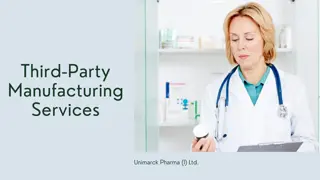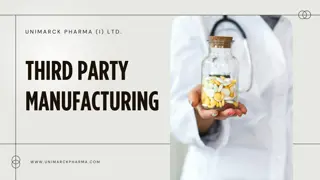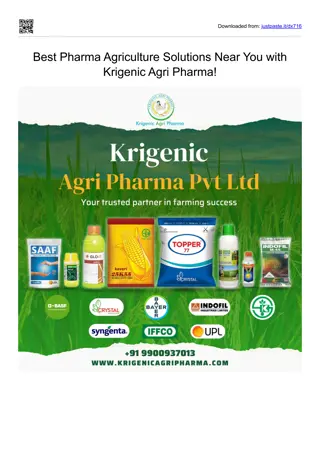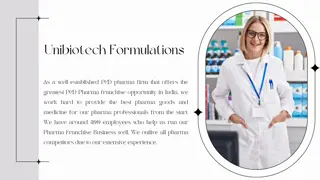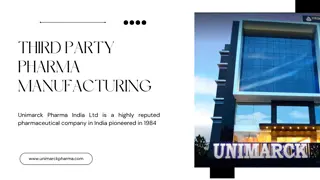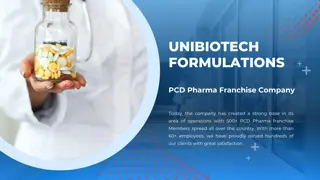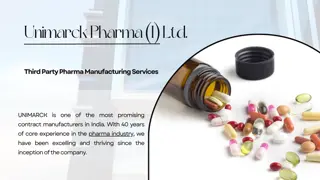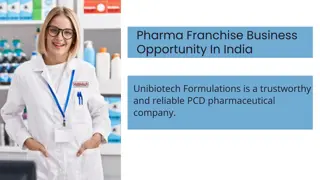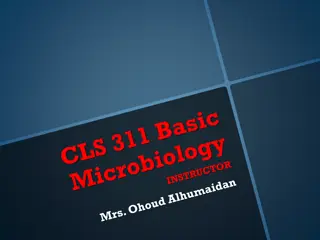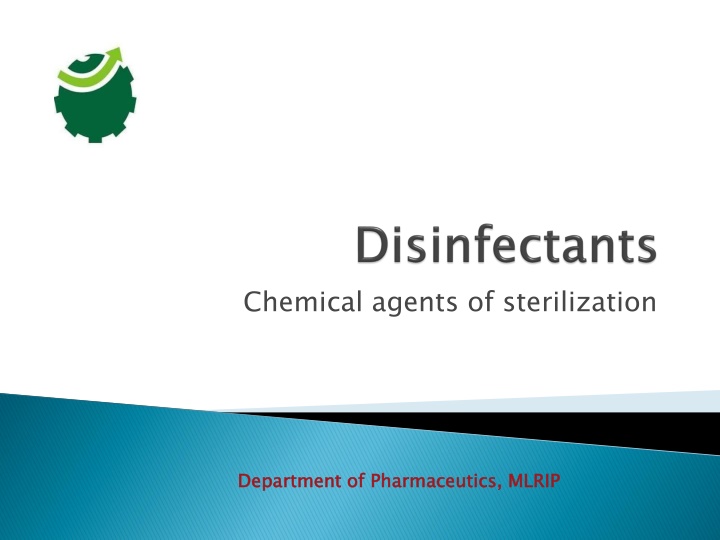
Chemical Agents of Sterilization and Microorganisms Testing in Pharmaceutics
Explore the chemical agents of sterilization and their role in eliminating microorganisms in the field of pharmacy. Discover the various factors affecting the efficacy of disinfectants, including physical and chemical elements, organic and inorganic matter, and duration of exposure. Delve into the testing methods for assessing the effectiveness of sterilization processes, such as carrier tests, practical tests, bactericidal tests, and sterility tests. Learn about the significance of sample size, dilution fluids, culture media, and interpretation of results in ensuring proper sterilization protocols are followed.
Download Presentation

Please find below an Image/Link to download the presentation.
The content on the website is provided AS IS for your information and personal use only. It may not be sold, licensed, or shared on other websites without obtaining consent from the author. If you encounter any issues during the download, it is possible that the publisher has removed the file from their server.
You are allowed to download the files provided on this website for personal or commercial use, subject to the condition that they are used lawfully. All files are the property of their respective owners.
The content on the website is provided AS IS for your information and personal use only. It may not be sold, licensed, or shared on other websites without obtaining consent from the author.
E N D
Presentation Transcript
Chemical agents of sterilization Department of Pharmaceutics, MLRIP Department of Pharmaceutics, MLRIP
Phenols & phenolic compounds Alcohols Aldehydes Halogens Dyes Detergents Heavy metals Quaternary ammonium compounds Gaseous agents
Number and Location of Microorganisms Innate Resistance of Microorganisms Concentration and Potency of Disinfectants Physical and Chemical Factors: temperature, pH, relative humidity, Water hardness.
Organic and Inorganic Matter Duration of Exposure Biofilms
Carrier tests Robert Koch Suspension tests- RWC, Chick Martin test, Disinfectant kill time test Capacity Tests Kelsey-Sykes test
Practical tests: Surface Time kill Test In-use test:
Bactericidal tests 1. The test organism is exposed to a suitable concentration of the disinfectant 2. Samples are taken at specified times and added immediately to a diluent or culture medium containing the appropriate disinfectant inactivator 3. The treated samples are cultured for surviving microorganisms.
The test for sterility is based on - micro-organisms are placed in a nutritive medium and kept at a favorable temperature, the micro-organisms will grow and their presence can be indicated by turbidity in the originally clear medium. Department of Pharmaceutics Department of Pharmaceutics
Sample size Dilution fluids Culture media Different methods Interpretation of results
1. Fluid A: it is prepared by dissolving1 gm of peptone in water to make 1000ml, clarified by filtration or centrifugation. The pH is adjusted to 7.1 0.2., and it is sterilized at 121o c for 20min in 100 ml quantities in flasks. Fluid B: It is fluid A to which 1ml of Tween 80/L has been added Department of Pharmaceutics Department of Pharmaceutics
Fluid Thioglycollate Medium Ingredients Gms / Litre Tryptone 15.000 Yeast extract 5.000 Dextrose (Glucose) 5.500 Sodium chloride 2.500 L-Cystine 0.500 Sodium thioglycollate 0.500 Resazurin sodium 0.001 Agar 0.750 Final pH ( at 25 C) 7.1 0.2
Alternate Fluid Thioglycollate Medium Ingredients Gms / Litre Tryptone 15.000 Yeast extract 5.000 Dextrose (Glucose) 5.500 Sodium chloride 2.500 L-Cystine 0.500 Sodium thioglycollate 0.500 Final pH ( at 25 C) 7.1 0.2
Soyabean Soyabean Casein Digest Medium Casein Digest Medium Ingredients Gms / Litre Pancreatic digest of casein 17.000 Papaic digest of soyabean meal 3.000 Sodium chloride 5.000 Dipotassium hydrogen phosphate 2.500 Dextrose monohydrate 2.500 pH after sterilization ( at 25 C) 7.3 0.2 Department of Pharmaceutics Department of Pharmaceutics
Method A: Membrane filtration Method B: Direct inoculation Department of Pharmaceutics Department of Pharmaceutics

